7 Extremely Weird Inventions From the Grandfather of Science Fiction
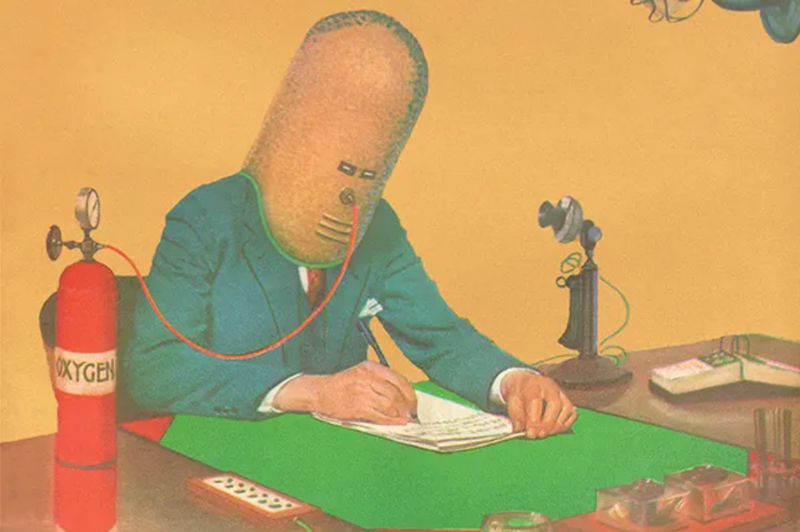
- Oops!Something went wrong.Please try again later.
Hugo Gernsback was a pioneer in the world of science fiction during the first half of the 20th century—so much so that the Hugo Awards are named after him. But Gernback also edited serious tech magazines and came up with ideas that were often way ahead of their time. Or, in the case of the office “isolator” pictured above, simply too weird for any time.
Born in Luxembourg in 1884, Gernsback moved to the U.S. in 1904 and it wasn’t long before he established himself as a writer with incredibly innovative ideas. In 1908, Gernsback founded his first magazine, Modern Electrics, the world’s first magazine devoted to electronics, often with a special focus on the budding new tech of radio.
In 1913, he started The Electrical Experimenter, which would become known as Science and Invention in the 1920s. And in 1919 he founded Radio News, with Television News launched in 1928, just a couple of years after the first experimental tests of TV. That doesn’t even include the sci-fi titles he started like Amazing Stories.
All of these serious-minded tech magazines had at least one article in every issue by Gernsback, and they often included ideas for futuristic inventions. They’re simply some of the most interesting old ideas for the future from a century ago.
Above we see Gernsback’s idea for cutting out all office distractions, dubbed “the isolator,” which was featured in the July 1925 edition of Science and Invention magazine and provided a fascinating snapshot into the sci-fi pioneer’s mind. You can read about that invention and more by clicking through the slideshow.
The Sleep Eliminator (1923)
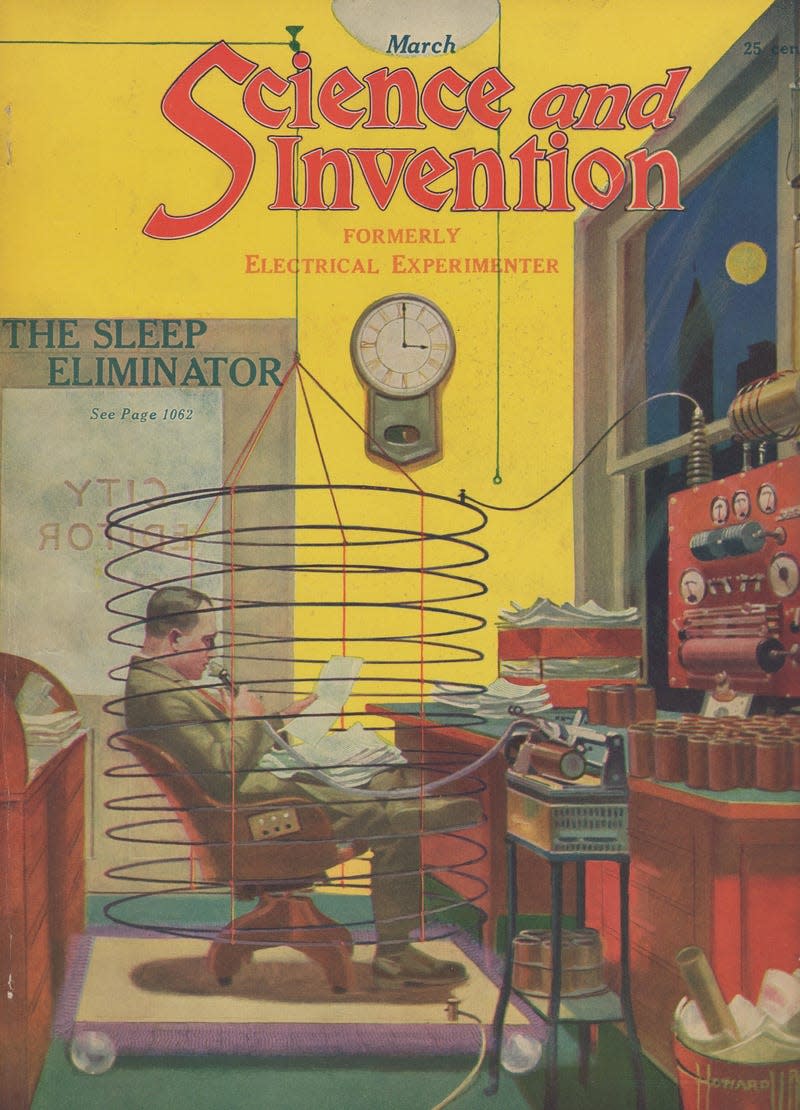
Office workers are generally used to that mid-afternoon lag where they reach for an energy drink or cup of coffee to make it through the rest of the day. But Gernsback had a special idea for how to keep people awake at their desks: tiny electric shocks.
The idea was that electrical energy from this “sleep eliminator” was supposed to be stimulating, mostly zapping the air around the worker. But the device Gernsback imagined also gave small shocks to that same person’s chair.
From the March 1923 issue of Science and Invention:
The oxygen, as well as the ozone with which the air is charged in small quantities, helps to rejuvenate the system. A secondary electrical system gives the nerves certain rhythmic shocks, almost imperceptible to the subject. These are used to stimulate the nerve cells that have become sluggish. It is thought that by these means sleep can and will be eliminated entirely.
Now, these shocks weren’t supposed to hurt the worker, but it’s easy to imagine this invention going south very quickly. It was extremely popular, after all, to give people electric shocks in the 1920s.
Doctor by Zoom Call (1925)
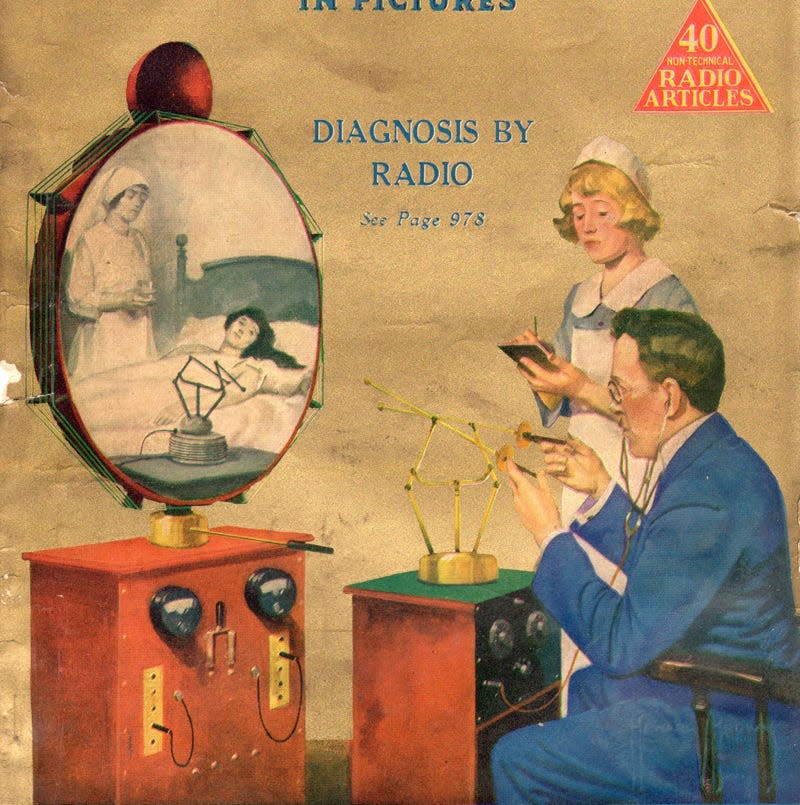
Telemedicine entered the mainstream in the early 2020s thanks to a global pandemic that pushed a lot of our lives online. And while remote surgery is still largely the work of science fiction, Gernsback imagined a device in 1925 that would make a doctor’s visit possible from great distances way earlier than others dared.
Gernsback called his invention the “teledactyl” and it would allow medical doctors to inspect patients using a television device and remote-controlled arms that were on the other side of the line.
From the February 1925 issue of Science and Invention:
The Teledactyl (Tele, far; Dactyl, finger — from the Greek) is a future instrument by which it will be possible for us to “feel at a distance.” This idea is not at all impossible, for the instrument can be built today with means available right now. It is simply the well known telautograph, translated into radio terms, with additional refinements. The doctor of the future, by means of this instrument, will be able to feel his patient, as it were, at a distance….The doctor manipulates his controls, which are then manipulated at the patient’s room in exactly the same manner. The doctor sees what is going on in the patient’s room by means of a television screen.
Gernsback even imagined the doctor experiencing the kind of bio-feedback that serious thinkers wouldn’t even be talking about for literal decades:
Here we see the doctor of the future at work, feeling the distant patient’s arm. Every move that the doctor makes with the controls is duplicated by radio at a distance. Whenever the patient’s teledactyl meets with resistance, the doctor’s distant controls meet with the same resistance. The distant controls are sensitive to sound and heat, all important to future diagnosis.
And given the fact that TV tech wasn’t even successfully demonstrated until the following year, this idea was well and truly ahead of its time.
Mechanical Matchmaker (1924)
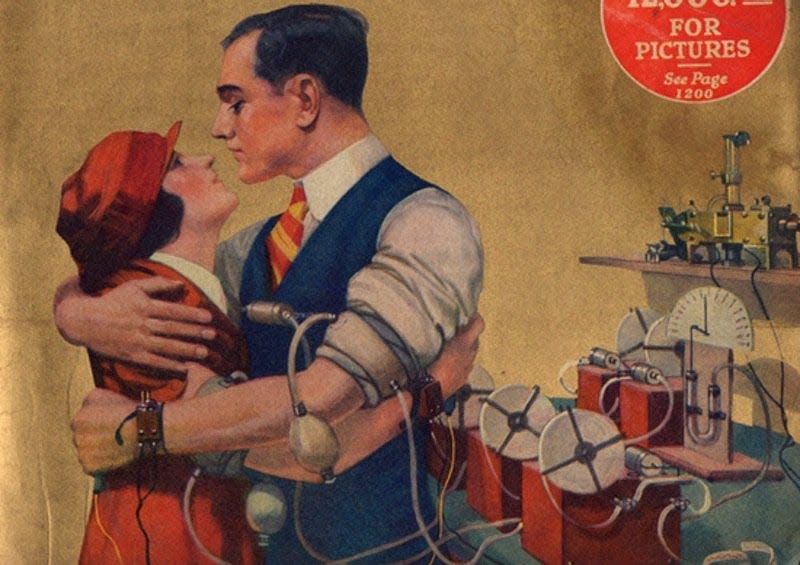
How do you know that someone is “The One?” Gernsback tackled that question in 1924 with an idea for an invention that was supposed to inject some science into the world of romantic attraction.
From the April 1924 issue of Science and Invention magazine:
How much would the average man or woman give to know beforehand if his or her prospective married life is to be success or failure? At present, marriage is a lottery. It seems impossible to predict beforehand how your prospective mate will turn out in the future. Through certain fundamentals, which can easily be ascertained, one can be reasonably certain as to one’s choice. We take extreme care in breeding horses, dogs and cats, but when we come to ourselves we are extremely careless and do not use our heads nor the means that science puts in our hands for scientific breeding. There are certain basic tests which can be made today and which will give one a reasonable assurance of married happiness.
Gernsback devised four different tests that were supposed to scientifically decide if two people were compatible including a physical attraction test, a sympathy test, and a body odor test. All of these tests involved people being hooked up to machines to determine what their heart rates were doing as an observer carried out the test.
But it was the fourth test that was arguably the weirdest. It was called the sympathy test and involved someone firing a surprise gunshot into the air. Seriously.
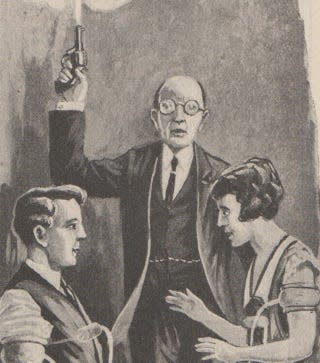
If both people are deemed to be too startled by the shot, they’re viewed as being too nervous and shouldn’t be paired up under the theory that one person should have nerves of steel. But if I’m sitting across from someone who doesn’t flinch at the sound of a surprise gunshot nearby, I’m not sure I’m going to think that’s a normal person I’d like to spend the rest of my life with.
The Thought Recorder (1919)
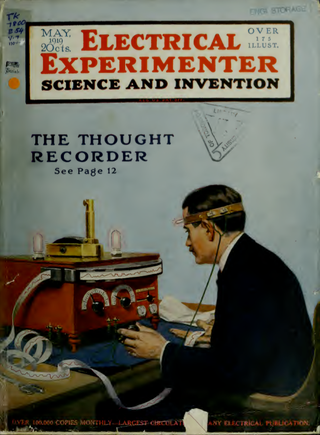
After the invention of the Audion, the tool in radio that allows for tremendous amplification of radio waves, Gernsback imagined it could be used to record a person’s thoughts.
From the May 1919 issue of Electrical Experimenter magazine:
The business man of tomorrow will dictate his correspondence on the thought recorder, while his stenographer, who is perfectly familiar with his “thought writing,” will type out the correspondence from the tape, which is kept moving by electric motors, in front of her eyes.
Gernsback presented his ideas to inventors like Nikola Tesla, Greenleaf W. Pickard, and Lee De Forest, who apparently seemed skeptical at first. But Gernsback said that Tesla eventually came around and that it might be possible.
“There is a possibility that we may finally succeed in not only reading thoughts accurately but reproducing faithfully every mental image,” Tesla reportedly said, according to Gernsback.
“It can be done thru the analysis of impressions to the retina, which is instrumental in conveying impressions to the nerve centers and, in my opinion, is also capable of serving as an indicator of the mental processes taking place within,” Tesla continued.
We’re obviously seeing all kinds of cutting-edge developments in the world of “mind-reading,” but this was another idea way ahead of its time in 1919.
The TV Autograph Signer (1935)
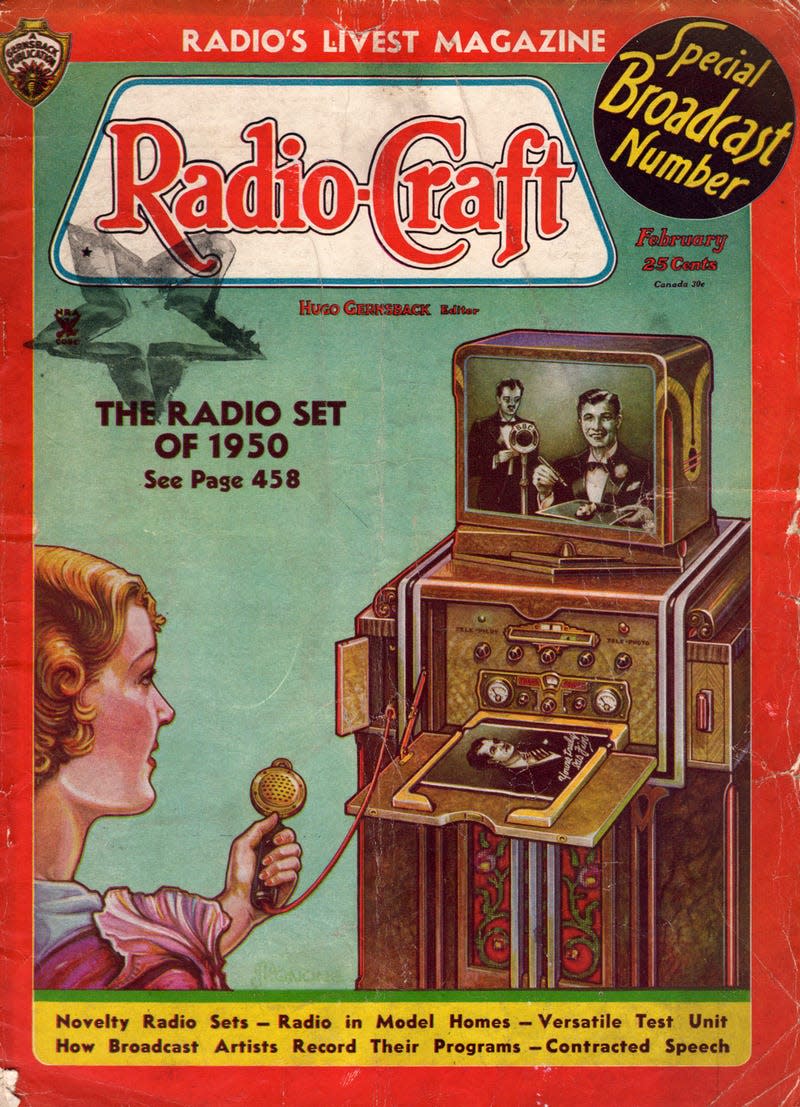
Have you ever been watching a musician on TV and wanted their autograph? That was going to be possible in the future, according to Gernsback, who imagined just such a device even before the vast majority of people had even heard of television.
From the February 1935 issue of Radio-Craft magazine
While you are looking at the artist on your television screen, the announcer will hand him a photograph, which he will autograph before your eyes. This photograph is then taken into the adjoining control room, where it is automatically transmitted on the same wavelength as that used by the broadcast station; and, in a few minutes, it will appear in front of your radio set in a slide provided for that purpose. The technical difficulties of doing this are but slight. It has already been demonstrated by several stations that television images can be sent out simultaneously with the sound impulses, over the same wavelength, without interfering with each other. The idea, therefore, of sending autographed photographs or other similar documents from the radio station to your own home and over your own set is, therefore, realizable even today. With certain refinements, the radio set of 1950, therefore, will not only be enabled to furnish you with your morning tabloid newspaper, giving you “spot” news information, but also autographed photographs and other memorable pictures that the enterprising station will wish to send out to its radio public.
Obviously, we need this for TikTok. Though someone still needs to work out how you deliver a signed paper through a phone.
Videochat During World War I
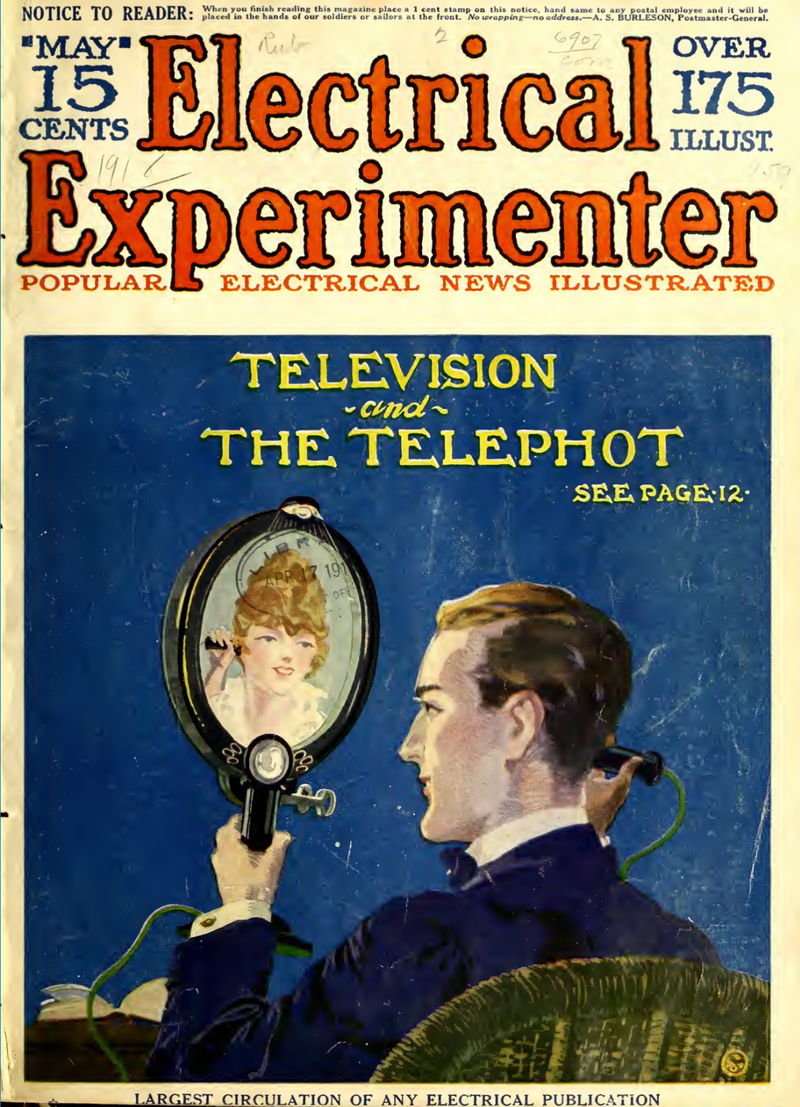
The videophone had a very long road to becoming mainstream. Once envisioned as a standalone device, the tech kind of snuck up on us in the 21st century via the backdoor of our phones and other devices. But Gernsback was way ahead of the curve in imagining dedicated video chat devices.
In fact, the sci-fi legend featured a very cool two-way video device on the cover of his magazine even back when radio was still considered new technology.
From the May 1918 issue of Electrical Experimenter:
The future instrument on which the name “Telephot”(from the Greek tele-far, photos-light) has been settled, is supposedly an apparatus attachable to our present telephone system, so that when we speak to our distant friend, we may see his likeness not only as an immovable picture, but we will see his image exactly as we see our own image when looking into a mirror. In other words, the apparatus must faithfully follow every movement of our distant friend whether he is only five blocks away or one thousand miles. That such an invention is urgently required is needless to say. Everybody would wish to have such an instrument, and it is safe to say that such a device would revolutionize our present mode of living, just as much as the tele-phone revolutionized our former standard of living.
The “tele-phone” indeed.
The Isolator (1925)
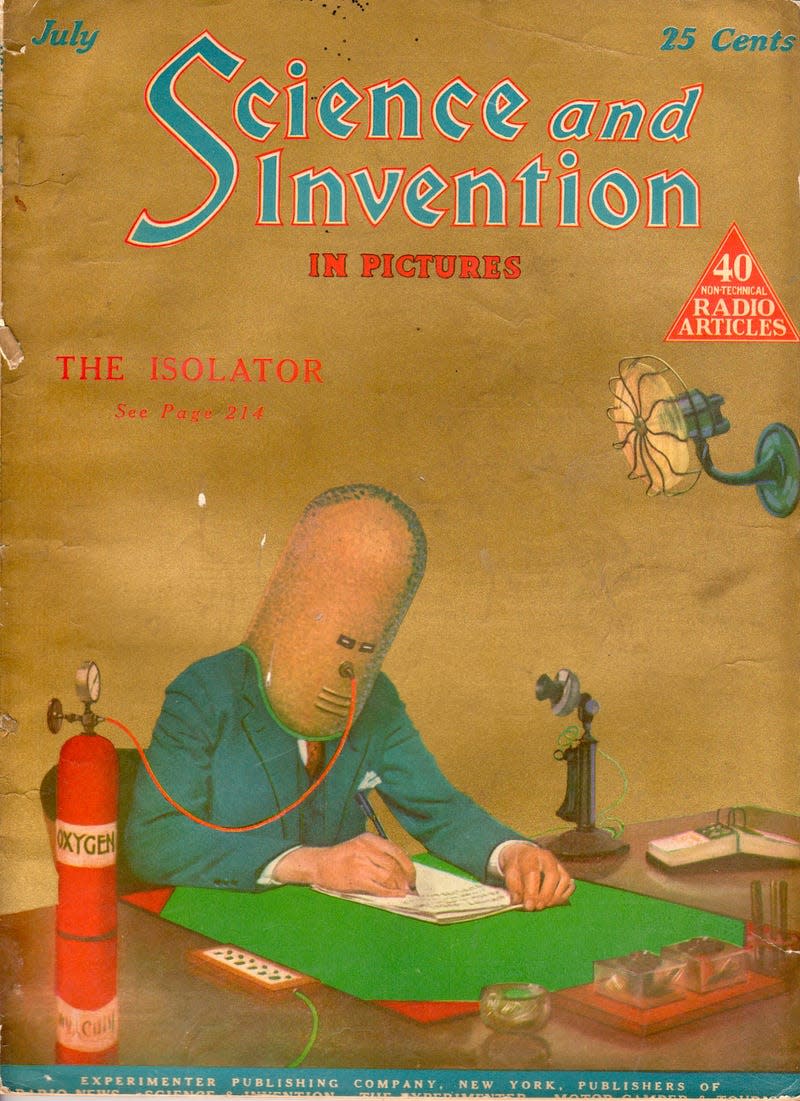
Last but not least, we have the invention we started with. Gernsback really did imagine that a new gadget might help people focus on the task at hand by creating a kind of isolation chamber for their heads.
From the July 1925 edition of Science and Invention magazine:
The writer, who has to perform almost daily, in connection with his editorial duties, many tasks that involve considerable concentration, has found out that it is almost impossible to keep his mind on a subject for five minutes without disturbance. For that reason, he constructed the helmet shown in the accompanying illustrations, the purpose of which is to do away with any possible interferences that prey on the mind.
Gernsback even explained how he built the device by trying different materials:
The problem was first to do away with the outside noise. The first helmet constructed as per illustration was made of wood, lined with cork inside and out, and finally covered with felt. There were three pieces of glass inserted for the eyes. In front of the mouth there is a baffle, which allows breathing but keeps out the sound. The first construction was fairly successful, and while it did not shut out all noises, it reached an efficiency of about 75 per cent.
Gernsback went on to explain that with some alterations he was able to construct a helmet that knocked out roughly 90-95% of all sound. The only problem? Gernsback said that after about 15 minutes, the wearer would become “drowsy.” The solution was to add an oxygen tank, which “increases the respiration and livens the subject considerably.”
Gernsback finished the article by calling the isolator “a great investment,” though I haven’t found any evidence he tried to sell any of these contraptions. The idea, it seems, was to put his idea out into the world so that people could build their own.

